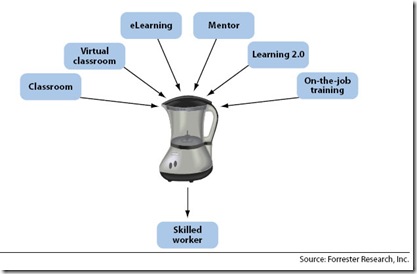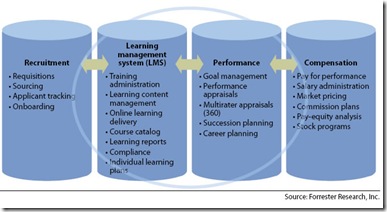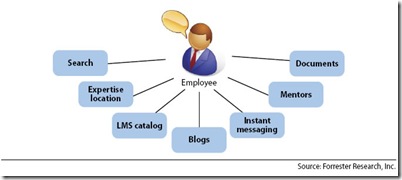I'm looking at some influences which are contributing to the emergence of informal and non-formal learning in the workplace. In my previous post on this topic, I outlined five change factors:
- Blended learning
- Talent management
- Web / Learning 2.0
- Knowledge centers
- Immersive learning simulations (serious gaming).
I will discuss the first three of these today.
Multiple-Channel learning or ‘blended’ learning is not a new learning approach, but it is becoming more common within training programs. Multiple-channel learning uses a range of learning modalities to train learners, as appropriate to the content and the context (see Figure 1). For example, a learning module might include some classroom learning, followed by some self-paced e-learning, with periodic online virtual classroom sessions for discussions. When learners reach a level of competence, they could be assigned mentors who work with them during their on-the-job training period.
 Figure 1. Multiple “Blended” Learning Channels
Figure 1. Multiple “Blended” Learning Channels
However, no formula exists for a successful multiple-channel learning course. The question that a learning and development professional must ask is,
What instructional blend is going to work best, given the kind of students, the nature of the content, and the skills these people need?
Sometimes blended learning includes just two modalities, like self-paced online learning along with virtual classroom for discussion and interaction. Sometimes a face-to-face component is central, with synchronous and asynchronous instruction, mentoring, or community of practice used for review, collaboration, and support.
Increasingly, employers struggle to attract and retain the best talent. Enter Human Capital Management. Organizations need the ability to seamlessly assess worker competencies and to provide employees with learning experiences that will close knowledge gaps and enhance job performance. Learning doesn’t stand by itself any longer — it’s integral to the other components of human capital management (see Figure 2).
 Figure 2. The Four Pillars Of Strategic Human Capital Management
Figure 2. The Four Pillars Of Strategic Human Capital Management
But unified learning and talent management systems don’t necessarily integrate. Many organizations have embedded legacy point solutions for learning, performance, and compensation. These solutions do not integrate well, and this inhibits seamless movement of information. For example, once a manager conducting a performance review identifies one or more employee competency gaps, the manager should then have the ability (through integrated applications) to assign learning directly to an employee learning plan that will help close the gap.
Learning 2.0 is a trend in which employees take more control of their learning and knowledge gathering. They decide what they need, where to go, and how to find information from a variety of resources both inside and outside of their corporate intranet (see Figure 3).
 Figure 3. Employees Drive Their Own Learning
Figure 3. Employees Drive Their Own Learning
To facilitate this, workers must have robust tools like expertise location, search, and instant messaging (IM) available to them, and they must know how to make the best use of these tools. A new mind set is required for Learning 2.0 to succeed. Many business leaders (and indeed HR departments) think of learning as classroom courses, even though most are beginning to grudgingly accepted e-learning as appropriate for certain kinds of training. Many people – especially those from a traditionalist or pre-digital era - are still skeptical about the place of informal tools in the work environment. The thinking goes:
Dollars allocated to learning are for formal courses, even though learning after formal college education takes place informally and non-formally.
Worse again, in certain “toxic” workplace environments individual or small group engage in the unsavory activity of empire building - where they attempt to gain control over key projects and initiatives in order to maximize their job security and promotability.
Empire builders hoard credit and prestige for projects, and knowledge-sharing is anathema to them. This approach prevents other people in the organization from contributing in a meaningful manner, and alternative or competing projects to address the project's goals are destroyed regardless of their merit. The outcome of empire building is, inevitably, that the organization suffers as a whole, projects fail, and organizational goals are achieved only partially, inadequately, or not at all. This sort of behavior is very common.
The tender shoots of non-formal learning will inevitably be destroyed by the weeds of empire building. For non- and informal learning initiatives to be implemented successfully, environment of sharing, where employees are expected to share rather than hoard information must be formed.
More...
_________________
References:
Schooley, C. (2008) Informal Methods Challenge Corporate Learning [Internet] Available from: http://www.forrester.com Accessed 12 March 2009





No comments:
Post a Comment